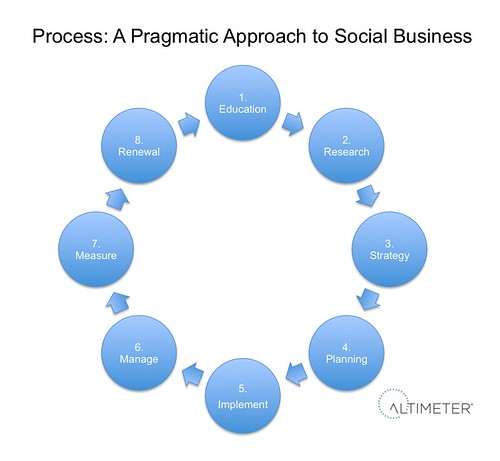Companies Who Start With Implementation Are At Risk.
In a frantic hurry to catch up with customers, companies often jump into social media without having a plan, which is a classic “leap before you look” approach. Soon, they find they are unable to scale as more customer adopt the tools, and are not ready for a long term engagement with customers even around negative conversations. While companies feel compelled join the conversation now to respond to customers, they should not throw out business planning. To avoid this predicament companies should step back and approach social business like any other business program: with a plan.

Instead, Follow A Pragmatic Process.
Start with gaining intelligence, by first getting educated about how business is changed, then develop a plan that aligns with the needed resources. While many of these phases are an ongoing effort, and have overlap to each other, this process is a designed to help corporations who don’t know where to start to use as a checklist. Education, Research, Measurement should be ongoing efforts across the entire program, but in order to get started this pragmatic set of steps are an ideal way to start. This process described below isn’t a new one, it’s a classic pattern found by most seasoned program and project managers, but I’ve added specific ‘social business’ questions to assist.
Process: A Pragmatic Approach to Social Business
| Phase | Description | Questions to Answer | Where to find resources |
| 1) Education | Become informed on the impacts of social technology to your customers, employees, and comapny | How have customers changed their behaviors? How has business changed due to this power shift? | Conferences, Books, Analyst Firms, Thought Leaders, Webinars |
| 2) Research | To document the changes in your specific market, and tools | How do my customers and employees use social technology? How will they in the future? What tools are most used? What are my competitors doing? | Socialgraphics studies, Research firms, Marketing Research departments |
| 3) Strategy | Defines specific goals of what is to be accomplished | What are the business goals? How will we measure success? How does this support the company and customers mission? | A combination of aligning to your executive leadership, agency partners, and your corporate social strategist |
| 4) Planning | Defines specific resources needed in what timeline | How much money do we need? What skills are needed? How much time is needed? When will we complete this? Which vendors do we need? | Agency partners, project managers, community managers |
| 5) Implementation | Initiating the plan | How will this be integrated into existing efforts? | Community managers, developers, agency partners, technology vendors. |
| 6) Management | Ongoing support of efforts | How will we keep this long term effort going forward? What resources and staff are needed for continual program growth? | Community manager, agency partners, technology vendors |
| 7) Measurement | How effective was our effort? | How well did we perform? What can we do better? What didn’t work, what worked and why? | Analytics and measurement groups, brand monitoring vendors, agency partners, and business intelligence providers |
| 8 Renewal | Improving the effort after understanding how it has been deployed | How can we improve this effort going forward? How can we integrate it? | All teams, but most importantly expand beyond the social team into the rest of digital marketing, events, and real world experiences. |
*Caveat: Many of these items such as education, research, and measurement should not be started then abandoned, but instead are an ongoing part of the overall program.
To get started, print this post out and use as a checklist for each of your social business initiatives: communities, blogs, Facebook pages, and beyond. Ensure that your strategy and plan has each of these elements in line as well as answers the resources required for each. In our recent webinar in Getting Your Company Ready for Social Business we discuss the importance of having a plan.
I’m a big fan of your writing and thinking, but here you have missed the mark. What you have provided is absolutely fine IF you believe change and transformation is a purely rational, logical set of actions. Every step in your process can have more sustainable impact if you focus on the heart as much as the head, on the dynamics of culture and competing values as much as operational planning for the desired initiatives.
This is why so many people nod their heads when educated about change that is ‘good’ for them and their business, only to do absolutely nothing different from before. You can still maintain the 8-step process, but at every step also look for resistance, competing values and organizational dynamics that run counter to the desired change. It’s both a process of individual change and one of systemic change….at least if you want change to last.
Thanks Jeremiah for emphasizing the need to put pragmatic social media plans and processes in place – these are great steps for companies to implement. I think it™s also important to note that unlike traditional channels, companies need to take into account the need for risk and be willing to fail fast-forward as speed, informed risk and opportunism might just lead to an unrealized competitive advantage or opportunity to innovate. The ability to continually learn, test, refine and improve helps you not only be first to market but also the best.
Best regards,
Jennifer Rodriguez
Director of Community Outreach, Visible Technologies
Thanks for sharing
Nice blog, thanx for the posting, will be bookmarking this page.
Thanks for the info, its really great to know about our Internet world, You selection is one of the best.
I like how you broke down the different compenents of running a Social Media Marketing business. It’s impressive and well organized.
Excellent post. Many useful tips!
Excellent post. Many useful tips!